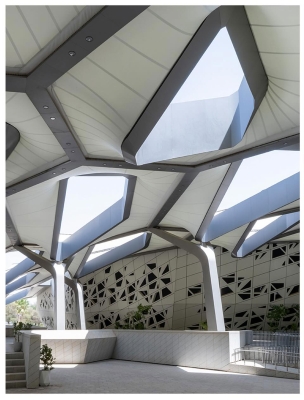




Exhibition of the Two Holy Mosques Architecture in Makkah al-Mukarramah
Inaugurated in 2000, the exhibition encompasses several halls that showcase the Islamic art of the Two Holy Mosques since the early beginnings of Islam. These halls include the Grand Mosque Hall, comprising al-Kaaba al-Musharrafa Ladder, which dates back over two hundred years, in addition to the enclosure of Maqam Ibrahim. The exhibition also features al-Kaaba al-Musharrafa Hall, which includes al-Kaabah al-Musharrafa's Pillar inside, dating back to the companion Abdullah Bin az-Zubair, may Allah be pleased with him, and al-Kaabah al-Musharrafa's Door. Additionally, it features the Manuscript Hall, the Prophet's Mosque Hall, and Zamzam Water.
Saudi National Museum in Riyadh
Inaugurated in 1999, the museum spans an area of 17,000 m and is distinguished by its collection of artifacts from prehistoric times to the modern era. It houses 3,700 heritage pieces, including statues, manuscripts, and sculptures, displayed across eight sections. These sections start with the Man and Universe Gallery, which introduces the formation of the universe, the solar system, and the factors that contributed to the universe's evolution over millions of years. The Ancient Arab Kingdoms Gallery features civilizations that flourished from the fourth millennium BCE to the second century CE. The Pre-Islamic Era Gallery presents various lifestyles before Islam. The Prophet’s Mission Gallery highlights the life of Prophet Muhammad, peace be upon him (PBUH), from the moment of the revelation to his migration to al-Madinah al-Munawwarah. The history of the unification of the Kingdom of Saudi Arabia is then presented through a documentary in the Kingdom Unification Gallery. Finally, the Hajj and Two Holy Mosques Gallery exhibits the urban development of the Holy Mosques in Makkah al-Mukarramah and al-Madinah al-Munawwarah.
Ithra Museum in Dhahran
The museum is home to five galleries of contemporary art, Saudi heritage, Islamic art, and the history of the Arabian Peninsula. Some galleries include interactive exhibitions, while others feature workshops, educational lectures, and customized tours. The museum also features temporary exhibitions organized by growing companies and permanent groups, showcasing artwork and crafts that represent both local and global cultures.
Dar al-Madinah Museum in al-Madinah al-Munawwarah
It is the first museum dedicated to the history of al-Madinah al-Munawwarah. It is divided into three main halls, the first of which is the Prophetic Biography Hall, showcasing miniatures and rare images of al-Madinah al-Munawwarah, demonstrating the landmarks of the Prophet's biography. Next is the Urban and Civilizational Development Hall, while the third is the Open Museum Hall or the Museum Garden. The museum displays a collection of rare artifacts related to the history of al-Madinah al-Munawwarah, including coins that circulated throughout the city's history, several pieces of pottery from the Umayyad era, a collection of Islamic manuscripts, and pre-Islamic jewelry. It also contains antiques, jewelry, and clothes once worn by the people of al-Madinah al-Munawwarah.
House of Islamic Arts in Jeddah
It is a museum dedicated to Islamic art. It features a collection of artworks representing Islamic civilization, that hold both historical and cultural value, and belong to various eras. The museum contains over one thousand pieces representing fifteen centuries of Islamic art history from various regions of the Islamic world.
Al-Masmak Palace Museum in Riyadh
The palace was established in 1865 and was later converted into a museum in 1995. It comprises seventeen halls that narrate the history of al-Masmak Palace, its purposes, and artifacts from the time of Riyadh's recapture and ancient Riyadh. It also features the well's courtyard, temporary exhibitions, the story of the Kingdom's unification, and the achievements of King Abdulaziz Bin Abdulrahman Al Saud, with accompanying photos, maps, miniatures, and explanatory films.
The historic al-Zaher Palace in Makkah al-Mukarramah
The construction of the palace, also known as "Makkah Museum," began in 1946 following the order of the founding King Abdulaziz Bin Abdulrahman Al Saud. It was later converted into a museum in 2006. The palace spans 3,425 m and comprises three floors. The ground floor is a grand hall featuring a colorful marble fountain at its center, topped by a dome supported by twenty-four circular columns. The museum houses various halls showcasing the Kingdom's landmarks and the archaeology of Makkah al-Mukarramah dating back to prehistoric and pre-Islamic eras. Additionally, it features halls dedicated to the Prophetic biography, the history of writing and coins, Hajj, the architecture of the Grand Mosque, the three Saudi states, Meccan heritage and education, and Islamic art collections.
Tayebat Museum in Jeddah
The museum offers a glimpse into the history of Jeddah, extending over nearly 2,500 years. It is a multiroom, multi-level complex that represents the architectural style of the old city, including its Rawashin decorated with wooden and coral embellishments. The museum features a model of Makkah al-Mukarramah and al-Kaaba al-Musharrafa, with information about Hajj and Umrah rituals and the locations of their performance, presented in English and Arabic. It also houses artworks, manuscripts, pottery, rare coins, weapons, and a map illustrating the spread of Islam worldwide. Additionally, the museum contains a section dedicated to the Red Sea and the Kingdom's history, showcasing images of the founding King with prominent global figures. The museum also displays artifacts related to Saudi culture and traditional garments, including bridal Hejazi attire.
Diriyah Museum in Salwa Palace
The museum houses exhibits that highlight the history of ad-Dir'iyyah, where Imam Mohammed Bin Saud laid the foundations for the rule of the First Saudi State, its social aspects, and architectural styles. It features the Saudi Social Life Museum, the Traditional Architecture Museum, the Museum of Treasury (Beit al-Maal), the Military Museum, and the Arabian Horse Museum.
Related quizzes
Related articles

